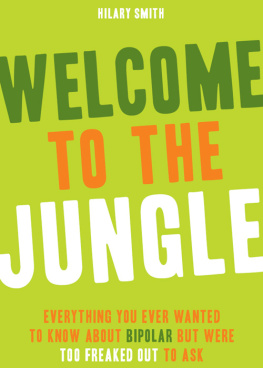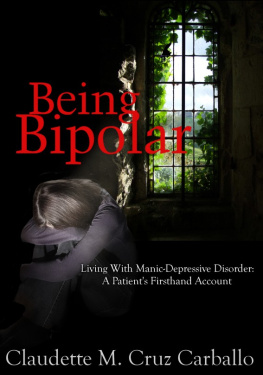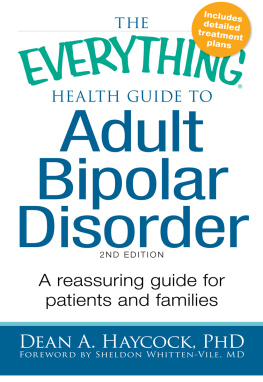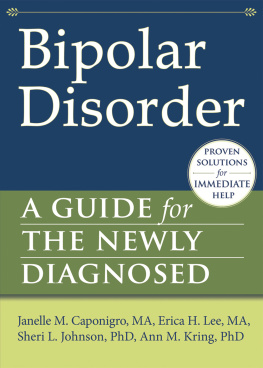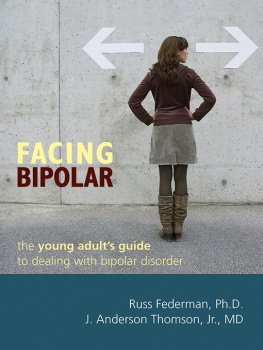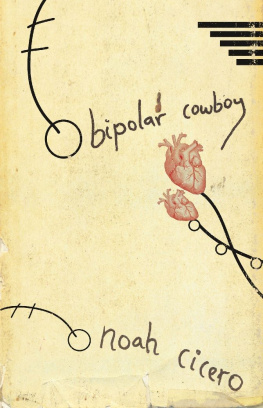PRAISE FOR WELCOME TO THE JUNGLE
Hilary Smith brings to light what those with bipolar already know: that just because you've been diagnosed with a mental illness doesn't mean you've lost your insight, intelligence, or playful (and often self-mocking) sense of humor. Welcome to the Jungle astutely captures the roller coaster of emotions that accompany bipolarfrom trenchant despair to uproarious maniaand does so in a way that never alienates the reader, but rather sucks you in and keeps you wanting to go along for the ride. Writing with a wisdom and faculty well beyond her years, Smith had me laughing out loudnot at her, but with her. Whether you're a teen for whom the diagnosis of bipolar is as raw and fresh as a snipped nerve, or in your twenties struggling with the disease for what seems like decades, Welcome to the Jungle is the quintessential young person's companion.
Malina Saval, author of The Secret Lives of Boys: Inside the Raw Emotional World of Male Teens
Hilary Smith's wise, hilarious, and candid book is a veritable lifesaver not only for those suffering from bipolar disorder, but for those struggling to keep their sanity while loving them. Maybe because the author suffers from the disorder herself, her book is an actual survival guide, brimming with insight, anecdote, and tough love. Recovery was never so inspiring.
Allison Burnett, author of Undiscovered Gyrl
By far the best, most comprehensive self-help book out there about bipolar disorder. Hilary Smith's incredible sense of humor, candor, and wit make her guide easy to read, a pleasure, and a laugh riot. Every person with bipolar (or family member or friend) should read this book as soon as possible. This book will save lives.
Andy Behrman, author of Electroboy: A Memoir of Mania
Funny, smart, and unflinchingly astute, Welcome to the Jungle is exactly the guide you want on your journey from chaos to stability as you learn to manage bipolar disorder. Smith's sure voice is a welcome companion over some hard road, and her wry wisdom lights the way. Indispensable.
Marya Hornbacher, author of Madness: A Bipolar Life and Wasted: A Memoir of Anorexia and Bulimia

First published in 2010 by
Red Wheel/Weiser, LLC
With offices at:
500 Third Street, Suite 230
San Francisco, CA 94107
www.redwheelweiser.com
Copyright 2010 by Hilary Smith
All rights reserved. No part of this publication may be reproduced or transmitted in any form or by any means, electronic or mechanical, including photocopying, recording, or by any information storage and retrieval system, without permission in writing from Red Wheel/Weiser, LLC. Reviewers may quote brief passages.
Library of Congress Cataloging-in-Publication Data
Smith, Hilary, 1986
Welcome to the jungle : everything you ever wanted to know about bipolar but were too freaked out to ask / Hilary Smith.
p. cm.
ISBN 978-1-57324-472-5 (alk. paper)
1. Depression in adolescencePopular works. 2. Manic-depressive illness in adolescencePopular works. 3. Smith, Hilary, 1986Health. 4. Manic-depressive illness in adolescencePatientsCanadaBiography. I. Title.
RJ506.D4S585 2010
616.85'2700835dc22
2009050798
Cover design by Sara Gillingham
Text design by Donna Linden
Typeset in Perpetua and Toronto Gothic
Printed in Canada
TCP
10 9 8 7 6 5 4 3 2 1
The paper used in this publication meets the minimum requirements of the American National Standard for Information SciencesPermanence of Paper for Printed Library Materials Z39.48-1992 (R1997).
This book is not intended to diagnose, treat, or prevent any illness or act as a substitute for advice from a doctor or psychiatrist.
CONTENTS
INTRODUCTION
This is a book about bipolar disorder. Or if you're a free spirit or an R. D. Laing enthusiast who doesn't believe in a pathological explanation of your extreme mood states, it's a book about living with the highs and lows everyone else in North America is calling bipolar disorder (the punks!). I'm supposed to use this introduction to tell you my personal story about being bipolar, but that can wait.
Right now I've got a hankering to write about shin splints.
I got shin splints when I was thirteen. They hurt. My Anglophilic boarding school made everyone participate in enforced jaunty after-school sports (and, every spring, supposedly jaunty sniper drills on the lawn). After a single week on the cross-country running team, jogging along behind the meaty-calved senior boys, my shins started to feel weird. Little shoots of pain sprang up each time my shoes hit the pavement. It really hurt, but I winced and kept running. If I ignored the problem, it would probably fix itself. Four practices went by. I limped along. During the fifth practice the coach (of whom I was terrified) rode up behind me on a bicycle and shouted, Stop running! You're limping! Go to the infirmary!
Confused and embarrassed, but relieved, I turned around and walked to the school physiotherapist's office, where a team of smokin' hot sports therapists treated me for shin splints. Going to physio was fun and cool: there were always tons of people there getting their ankles wrapped or their sprains ultrasounded, or just hanging out in the whirlpool drinking from sketchy-looking Nalgene bottles. The physiotherapists teased me about letting my shin splints get so bad without asking for help. I did the stretches and exercises, got a better pair of running shoes, and eventually started running again.
Total days of pain: less than five.
Social approval of shin splints: high.
Overall experience with shin-splints diagnosis and treatment: supercool!
Six years later, I was a junior at the University of British Columbia, majoring in English literature. No more sports, no more sniper drills. This was the West Coast, babypoetry readings, pot, and rainy-night house parties. I lived in a funky old house in Kitsilano that had a rich history of student debauchery and was known to several generations of UBC students as the place to go for anything involving mint juleps and knife throwing. Six of us lived there, and it got loud.
In January of that year, I started having trouble sleeping. Writing it off to the constant noise and stimulation in the house, I didn't pay much attention. By February I couldn't sleep at all, and my mind was swimming in thoughts and rhymes. Box! Fox! Haha!
In lectures, I either scribbled furiously in the diary I carried with me everywhere, recording my urgent insights (He was an ornithologist. He was bornithologist into it!), or I stood up abruptly to leave partway through and weep in the bathroom or wander in the forest that surrounded the campus. At parties, I would give my phone number to several different guys, then panic and jog home through the night, all the way from East Van to Kitsilano. At my part-time job as a bagel-stand cashier, I would prop my ever-present diary over the cash register and worry about the people who came to buy bagels: whether they knew what I was thinking, if they might be interested in coming to a fabulous party I was planning. At night, I would lie down in bed as a formality, then spring back up ten minutes later when sleeping didn't work out. Eventually, the mental chatter in my mind intensified so much that it felt like there were four of me whose constant arguments and repartees were alternatingly sinister and hilarious.
It really hurt, but I winced and kept going. If I ignored it, it would probably fix itself. Time passed. I limped along. Even though whatever was wrong with me was more pronounced than a physical limp and should have been more obvious, there was no coach to ride past on a bicycle and shout, Stop running!

